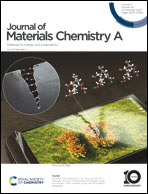Enhancing the electrostatic potential difference of high entropy perovskite fluorides by ligand modification for promoted dynamic reconstruction†
Abstract
High-entropy perovskite fluorides are very promising for the electrocatalytic oxygen evolution reaction (OER). However, the low kinetics of reconstruction reactions restrict their high catalytic activity. Herein, a novel strategy was developed for the modification of the surface K(CoMnFeNiCr)F3 (HEPF) using the electron-donating group pyrrolidone, for the first time, to promote the rate of reconstruction reactions. The experimental results and theoretical calculations demonstrated that after HEPF modification, the energy barrier for OH− adsorption was reduced to −5.37 eV. The surface modification with HEPF also enhanced the intrinsic conductivity owing to the improved band structure. This resulted in the formation of highly active catalytic species at lower potentials, leading to superior intrinsic catalytic activity. The optimized electrocatalyst exhibited an overpotential of only 242 mV at 10 mA cm−2, representing the best-reported value among similar materials. Overall, the proposed strategy looks promising for unlocking the excellent catalytic activity of high-entropy perovskite fluorides, useful for future syntheses of OER catalysts.



 Please wait while we load your content...
Please wait while we load your content...